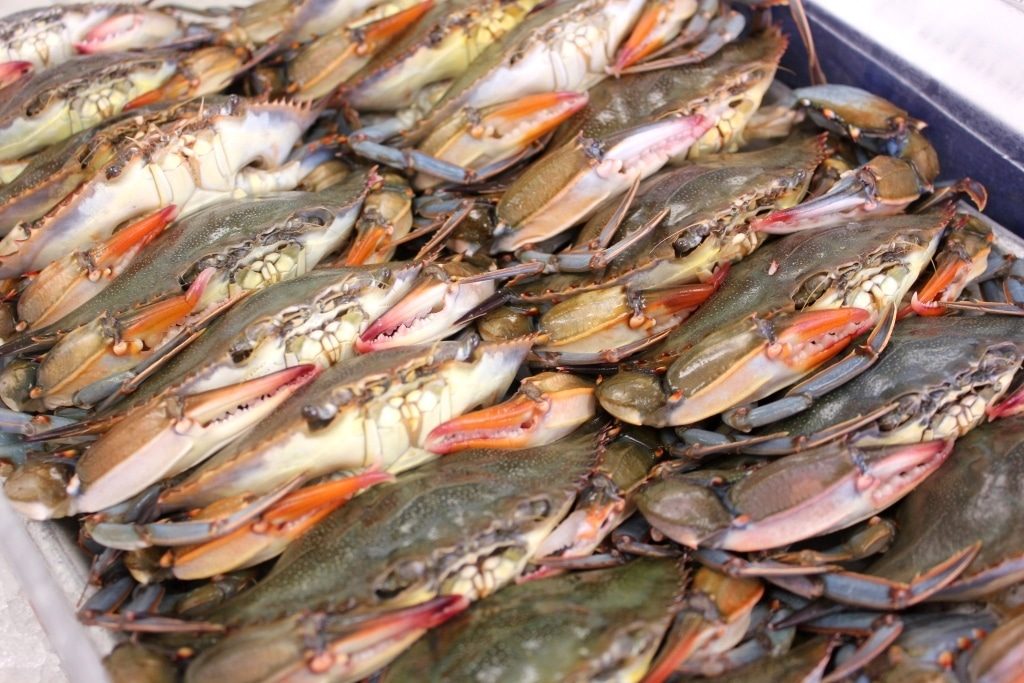The concept behind quick-cooking seafood in a seasoned stock, exactly what we do more often than not with crabs and shrimp, is, in fact, a French idea. We talked about it a few weeks ago when we had a chat about crawfish (I am including Max Ly’s crawfish boil recipe again, see below, it works just as well for crabs). But there are many more delicious things that you can do with crabs, other than just boiling them.
Perhaps my favorite is crab cakes. A chef friend of mine is fond of saying that what makes crab cakes so good is the crab. The point, obviously, is that many restaurants are selling bread cakes with a hint of crabs (don’t worry, I am not going to call you out!). Yes, I do understand the importance of controlling food costs, but I think that putting out a superior product is more important than padding your bottom line. Make an honest crab cake and charge an honest price. Nuff said.
Chef Alex Perry (yes, he is a good friend and I do talk about him a lot), makes his crab cakes by binding them with homemade saffron mayo. It is a simple, but not a cheap process.
1 cup canola oil
1 whole egg
1 pinch saffron (find it at Rouses)
1 small pinch salt
An immersion circulator and a cup just barely larger than the head of the circulator is what makes this recipe for mayo so simple. Add a tablespoon of very hot water to the saffron, and let it sit for 5 minutes. Combine all the ingredients in the cup, and pulse the circulator to get the mayo going, it should not take more than 20 seconds or so.

Pick the crab to make sure there are no small pieces of shell, season lightly (Tony’s is fine, but don’t add extra salt). Now start combining the crab meat and mayo, making sure not to break up the clumps of crab meat. The goal is to get the crab mixture to stick together when you form a cake. Use your hands, pat it back and forth ten times, compressing and removing any excess liquid. If you have problems making them stick together, add a half a cup of Panko bread crumbs. Just don’t overdo it. Sauté the cakes in butter until well browned and serve with a dollop of mayo on top.
This recipe is so good, it also makes for a great crab dip. Just add enough saffron mayo to get the consistency you like and serve with crunchy pita chips. You can spice the dip up a bit by adding capers and red onion.
We have talked before about aquafarming oysters, but did you know that the USM Research lab is now farm raising soft shell crabs? So far, it is a quiet revolution, but aquafarming is the future of the seafood industry. Lots of the old timers are scoffing at the idea, especially the price that boutique, farm-raised oysters are getting, but chefs are going nuts over the quality and those that truly enjoy the delicious oyster, don’t seem to care what they cost.
The commercial availability of US farm raised soft shells is a way off, the right investors have to be found, and the markets have to be studied, but the day is coming. When Murder Point started farm raising oysters in Alabama, and fine dining restaurants were charging $3.50 each for them, the same old-timers scoffed. Today, you can buy Murder Point oysters all over the country and they represent the gold standard. Wipe that smirk off your face.
I have to tell you a funny story: A friend of mine lives in Maryland and she is fond of telling me how much better Maryland blue crabs are than their Mississippi cousins. I asked a scientist who works for DMR what the difference in Maryland and Mississippi crabs is, and she said, “Nothing.” It is exactly the same creature. In fact, Maryland is wise enough to have a season for crabs and when they are out of season there, guess where the restaurants buy their crab from? You guessed it, the Gulf of Mexico and the Mississippi Sound.
Max Lee’s Crawfish seasoning
1 bunch celery
3 large red onions
2 large oranges
4 jalapenos
2 whole garlic cloves cut in half
4 tablespoons salt
½ cup sugar
2-3 tablespoons red pepper flakes
1 stick butter
1 bag ice
Chop the vegetables and fruit, fill the stock pot ⅔ full of water and bring to a boil. Add all of the ingredients and return to a boil for 10 minutes. Turn off the heat and allow to cool completely. This step really intensifies the flavors, so don’t skip it. Bring it back to a boil, add the crawfish and simmer for 10 minutes, then turn the heat off add the ice to stop the cooking process and allow it to sit 10 more minutes. Strain and dig in!